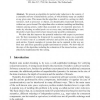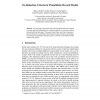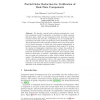STTT
2010
14 years 21 days ago
2010
Abstract. Partial order reduction limits the state explosion problem that arises in model checking by limiting the exploration of redundant interleavings. A state space search algo...
STTT
2010
14 years 4 months ago
2010
Abstract. Runtime (dynamic) model checking is a promising verification methodology for real-world threaded software because of its many features, the prominent ones being: (i) it ...
FMSD
2002
14 years 5 months ago
2002
Combining verification methods developed separately for software and hardware is motivated by the industry's need for a technology that would make formal verification of reali...
ENTCS
2007
14 years 6 months ago
2007
Software model checkers are typically language-specific, require substantial development efforts, and are hard to reuse for other languages. Adding partial order reduction (POR)...
IPL
2008
14 years 6 months ago
2008
In this article we analyze the combination of ACOhg, a new metaheuristic algorithm, plus partial order reduction applied to the problem of finding safety property violations in co...
ENTCS
2006
14 years 6 months ago
2006
In the past, partial order reduction has been used successfully to combat the state explosion problem in the context of model checking for non-probabilistic systems. For both line...
SAM
2004
14 years 7 months ago
2004
We propose a partial order reduction for model checking security protocols for the secrecy property. Based on this reduction we develop an automatic tool that can check security pr...
CONCUR
2008
Springer
14 years 7 months ago
2008
Springer
We present an algorithm for partial order reduction in the context of a countable universe of deterministic actions, of which finitely many are enabled at any given state. This mea...
FSTTCS
2006
Springer
14 years 9 months ago
2006
Springer
In recent papers, the partial order reduction approach has been adapted to reason about the probabilities for temporal properties in concurrent systems with probabilistic behaviour...
FORMATS
2007
Springer
14 years 10 months ago
2007
Springer
Abstract. We describe a partial order reduction technique for a realtime component model. Components are described as timed automata with data ports, which can be composed in stati...



